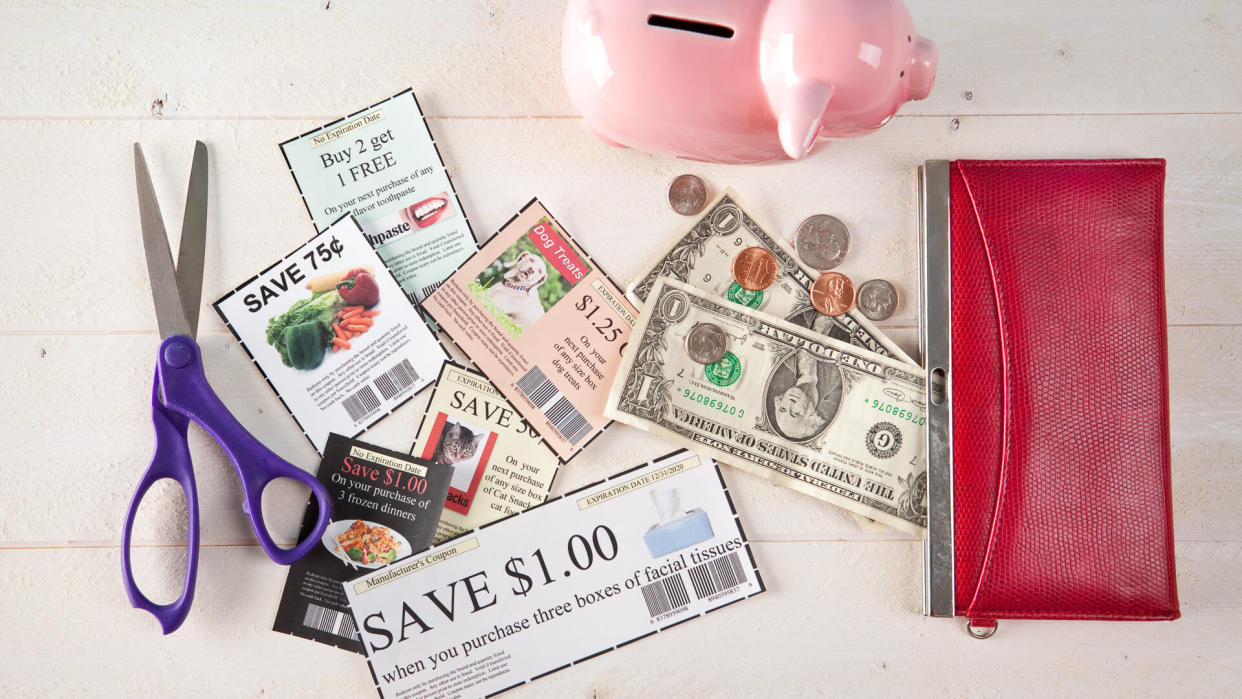How To Start Couponing: A Beginner’s Guide

Have you ever been grocery shopping and just before ringing you up, the cashier asks, “Do you have any coupons?” A “yes” answer can make you feel like you’ve hit the jackpot. Read on to learn more about how you can save some money on future grocery bills by couponing.
Read: 3 Signs You’re Serious About Raising Your Credit Score
What Is Couponing?
Most people usually think of a coupon as a printed ad that can be cut out to get a discount on products or services. Savers typically clip printed manufacturers’ coupons from newspapers, magazines and flyers they receive in the mail to save money at store checkouts.
Today, though, couponing primarily is done via digital platforms, making it even easier for you to save money.
How To Coupon
With the change in the coupon landscape, is it still worth it? Do you actually save money? The answer to both of these questions is yes.
Learning how to coupon isn’t difficult, but it requires organizational skills and a commitment of a decent amount of time every week. You’ll need to set up a system of gathering and sorting them so that you can easily find the ones you need when you’re looking for them, and finally, remember to use them.
There are two main ways to coupon:
Paper couponing
Digital couponing
1. Paper Couponing
No matter what method you employ, be mindful of the expiration date. Sort your coupons frequently to find those that expire in the next 10 days or two weeks, and dedicate a sheet in your binder or a section in your accordion file to coupons expiring soon.
Find Your Paper Coupons
Before you can develop that system, you’ll need to find coupons. Start looking for them in these places:
Sunday papers: They contain “books” filled with coupons to clip, primarily for groceries and household items, such as cleaners and detergents.
Weekly store ads: Your local grocery store ads, often found in the Sunday newspaper, sometimes contain coupons to clip, such as $2 off a $6 purchase from the dairy department. The circulars generally are available at the store’s entrance.
In-store coupons: Your supermarket might have a machine located near the entrance that dispenses coupons if you swipe your store loyalty card. These can contain offers for everyone or ones specifically catered to you.
Checkout coupons: When you pay for your groceries, the store clerk might hand you some paper coupons along with your receipt, and those could include offers based on what you just bought.
In the mail: Depending on where you live and your local stores, your weekday mail could contain some great deals.
Online coupons: These are available on a variety of websites that you can download and print.
Organizing Your Paper Coupons
Once you’ve clipped, you’ll need to organize all of your snips. They don’t do you any good sitting in a pile on the kitchen table. Here are some methods to help you with your organization.
Extreme couponers: These savers often shop with a binder filled with plastic sleeves containing hundreds of paper coupons. They often label the sleeves by type of item such as condiments or produce, then put each coupon that falls into that category into a sleeve.
Accordion file: Found at most dollar stores, these organizers have tabs that can be labeled and can help to separate your coupons. You’ll want to expand to a binder system if you get enough volume.
2. Digital Couponing
Clipping digital coupons requires no scissors or little pieces of paper to keep organized. However, this doesn’t mean it is necessarily less time-consuming.
Find Your Digital Coupons
If you don’t have online accounts with your favorite grocery stores, create them now on your home computer or tablet or by downloading the store’s app. The same goes for big-box stores like Target as well as drug stores like CVS and Walgreens.
On the store sites, you’ll find savings to sort through, and then you’ll “clip” coupons to your account. You can wade through them one by one or do a targeted search if you’re looking for something specific.
These “clippings” will stay in your account until you use them or they expire. To use them, you’ll present your linked loyalty card at the register — or in the case of stores like Target, enter your phone number on the terminal — and watch your savings come off before the final amount due is tabulated.
You also can locate savings on designated coupon websites.
Organizing Your Digital Coupons
A downside to this digitalization is that these savings are scattered throughout cyberspace on one coupon site or another. A couponing journal can help. Start with a small notebook to record and organize the coupons you’ve clipped. Dedicate pages to specific items.
For example, create a page labeled “Shampoo” and record the coupons you’ve clipped by product, amount, store and expiration date. Your entry will look something like this:
Pantene. $2. CVS. 4/1/23
Cross off the entry as you use it or as it expires. Use standard notebook paper for this task, and be sure to alphabetize the pages as you go.
5 Tips for Better Couponing
Now that you’ve begun your couponing journey, these additional tips will prove valuable.
Match your shopping list with expiring coupons
Buy only what you need
Coupon stack
Read the fine print
Don’t pay more than you need to
1. Match Your Shopping List With Expiring Coupons
You might not have salad dressing on your shopping list, but you have a great coupon for $2 off your brand that expires this week. Buy the dressing this week while you can benefit from the discount and have it on hand when you run out.
2. Buy Only What You Need
You don’t need that salad dressing this week, but it’s a staple and you know you’ll use it. But what if you see a coupon for black olives for $2 off and notice in the store circular that the same brand is on sale for $2.59? Cash in your savings and you’ll get olives for 59 cents.
It’s a great deal — if you like olives or have a recipe that requires them. If the can sits on the shelf for three years and you wind up tossing it, it wasn’t a good deal.
3. Coupon Stacking
If you have two $1 off manufacturers coupons for the same brand of laundry soap, you can’t combine them to get $2 off one bottle. But that doesn’t mean you can’t double coupon dip on the savings in some instances.
It’s called coupon stacking, and if you’ve got a manufacturer’s discount and a store discount for the same item, you certainly can “stack” them as long as the store allows it.
4. Read the Fine Print
Before you put the item in your cart, read the coupon requirements to be sure you have the right size and quantity. The coupon might be good only on a tube of toothpaste that’s 3.5 ounces or larger, for example. The 2.7-ounce tube you have in your hand won’t qualify.
5. Don’t Pay More Than You Need To
You have a coupon for $1 off a jar of national brand peanut butter and clip it, intending to use it. But when you get to the store, the peanut butter sale price is $4.99. The store brand you usually buy is $3.69. Use the coupon and you’re spending 30 cents more than you have to.
Final Take
The savings with coupons can be significant. Even if you save just $10 a week while grocery shopping, that’s $520 at the end of the year — $520 you can put in savings to build an emergency fund, put toward the down payment on a car or use to invest in stocks. And the reality is, the more effort you apply, the more you can save.
FAQ
Here are the answers to some of the most frequently asked questions regarding couponing.
What is the trick to couponing?
There are many tricks to couponing including knowing where to find coupons such as newspapers or websites, how to organize them and when to use them to get the most bang for your buck.
How do extreme couponers get their coupons?
Extreme couponers primarily get their coupons through print sources such as store ads, newspapers or in the mail. These savers often shop with a binder filled with plastic sleeves containing hundreds of paper coupons.
Can you really save money couponing?
Yes, you can really save money couponing if you are willing to put the time in to collect and organize them. You can collect them physically through store ads, newspapers, at the grocery store or visit coupon sites to download them.
Caitlyn Moorhead and Kathy Evans contributed to the reporting for this article.
This article originally appeared on GOBankingRates.com: How To Start Couponing: A Beginner’s Guide






